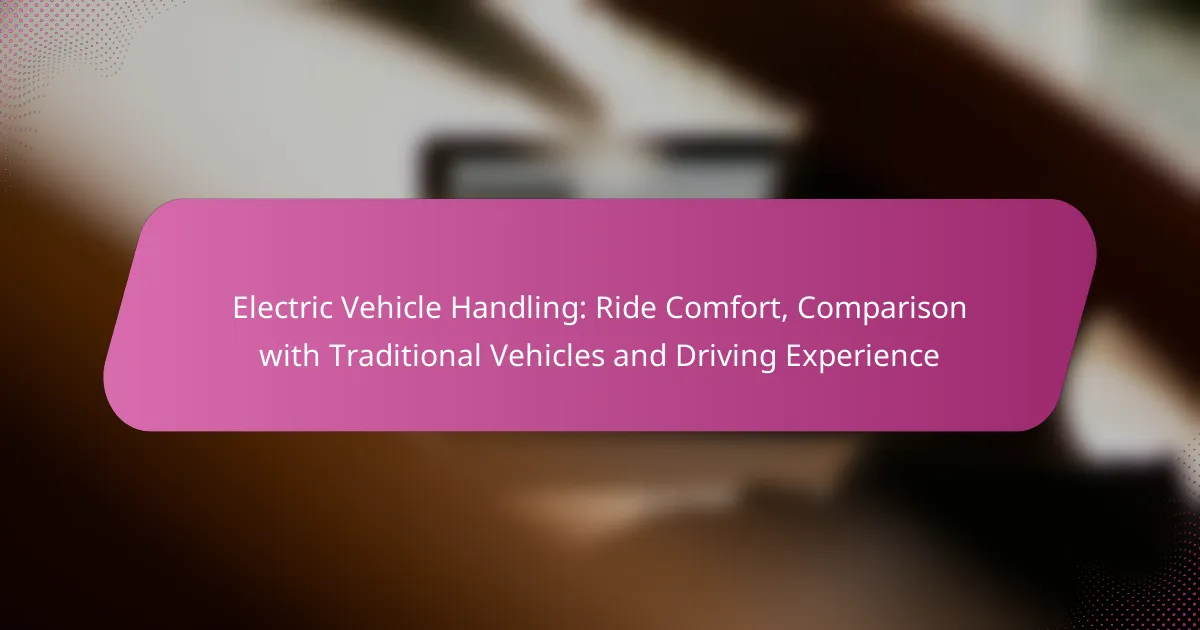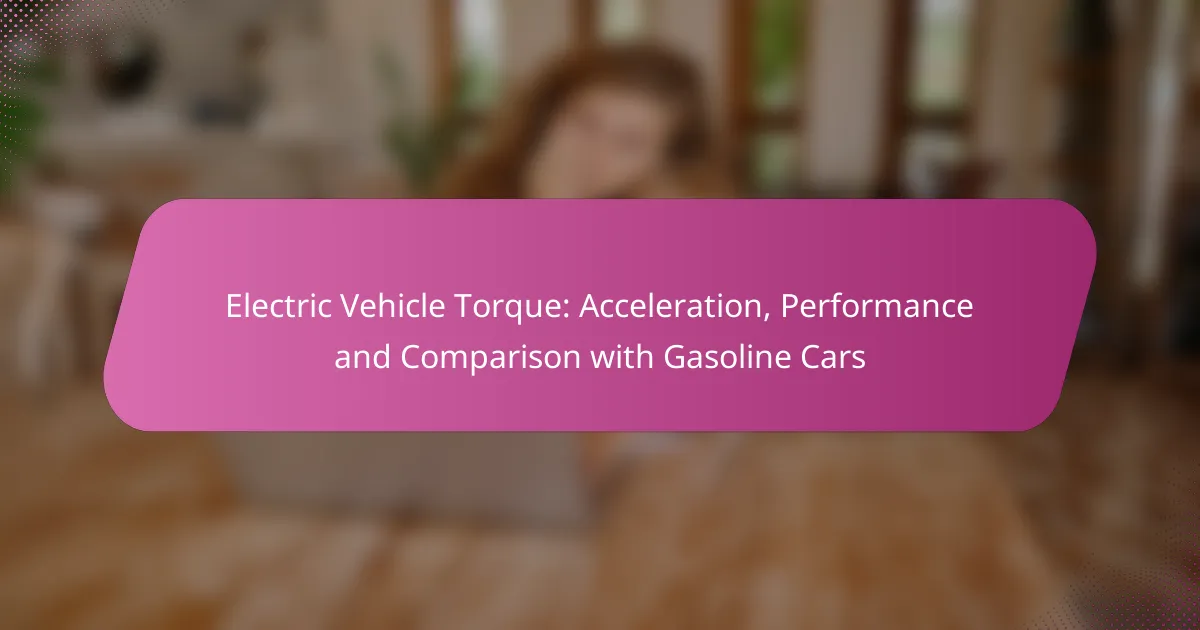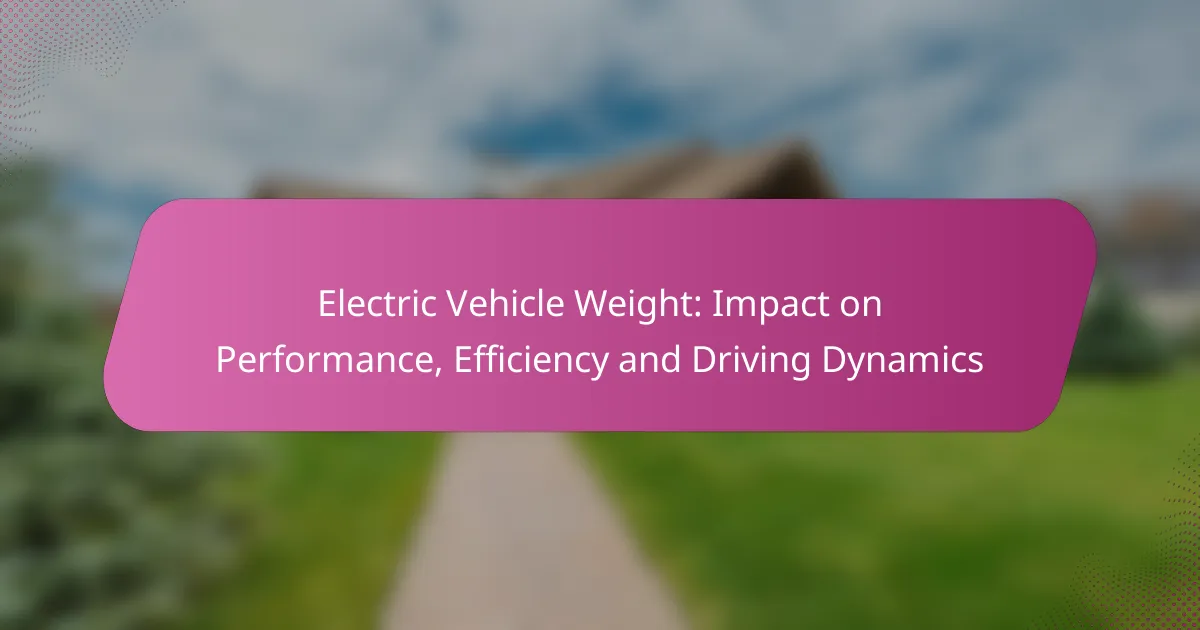Electric vehicles (EVs) provide a distinct ride comfort experience that sets them apart from traditional vehicles, influenced by their innovative design and technology. With factors like suspension systems, weight distribution, and noise levels, EVs enhance handling and stability, offering a unique driving experience characterized by instant torque and regenerative braking. Understanding these elements reveals the advantages of EVs in terms of comfort and performance on the road.
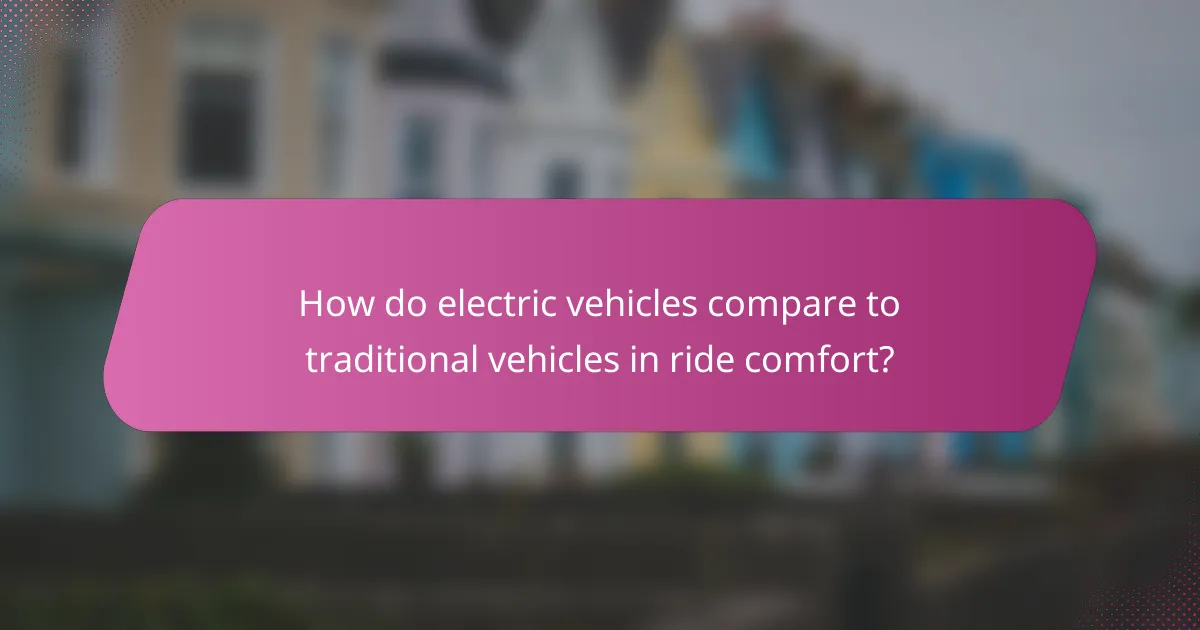
How do electric vehicles compare to traditional vehicles in ride comfort?
Electric vehicles (EVs) generally offer a different ride comfort experience compared to traditional vehicles, primarily due to their design and technology. Factors such as suspension systems, noise levels, weight distribution, and handling characteristics play significant roles in determining overall comfort.
Electric vehicle suspension systems
Electric vehicles often utilize advanced suspension systems designed to enhance ride comfort. Many EVs feature multi-link or air suspension setups that can adjust to road conditions, providing a smoother ride. This adaptability can lead to improved handling and a more pleasant driving experience, especially on uneven surfaces.
Noise reduction in electric vehicles
One of the notable advantages of electric vehicles is their quieter operation compared to traditional combustion engine vehicles. EVs produce minimal engine noise, which can significantly enhance passenger comfort during travel. However, road and wind noise can still be present, so manufacturers often incorporate sound-deadening materials to further reduce overall noise levels.
Weight distribution effects
Electric vehicles typically have a lower center of gravity due to the placement of heavy battery packs, which can improve stability and handling. This weight distribution helps reduce body roll during cornering, contributing to a more controlled and comfortable ride. However, the added weight can also affect tire wear and fuel efficiency, which should be considered when evaluating overall performance.
Driver feedback and handling
EVs often provide instant torque, which can enhance the driving experience by delivering quick acceleration. This responsiveness can lead to a more engaging driving experience, allowing drivers to feel more connected to the vehicle. However, some drivers may find the steering feel in certain EVs less communicative compared to traditional vehicles, which can affect their overall satisfaction with handling.
Passenger comfort levels
Passenger comfort in electric vehicles is generally high, with many models featuring spacious interiors and high-quality materials. The absence of an internal combustion engine allows for more flexible cabin designs, often resulting in quieter and more comfortable seating arrangements. Additionally, features like climate control and advanced infotainment systems can further enhance the overall comfort for passengers during longer journeys.
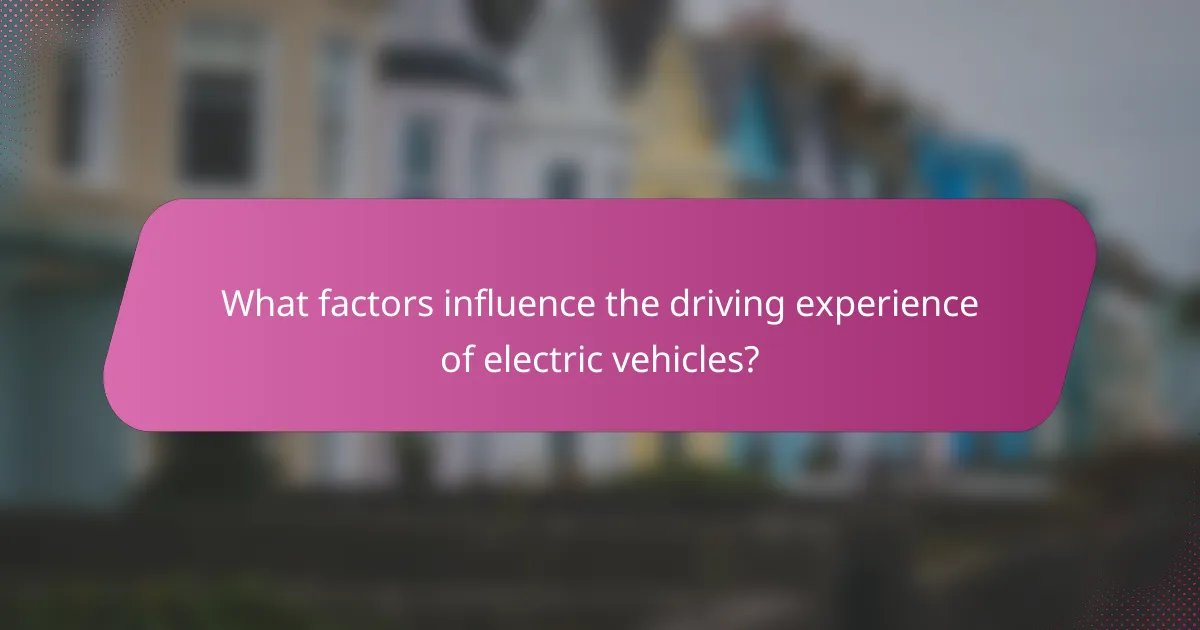
What factors influence the driving experience of electric vehicles?
The driving experience of electric vehicles (EVs) is shaped by several key factors, including instant torque delivery, regenerative braking, and customizable driving modes. Understanding these elements can help drivers appreciate the unique advantages and characteristics of EVs compared to traditional vehicles.
Instant torque delivery
One of the most notable features of electric vehicles is their instant torque delivery. Unlike internal combustion engines that require time to build up power, EVs provide maximum torque from a standstill, resulting in rapid acceleration. This characteristic allows for a more responsive driving experience, making it easier to merge onto highways or navigate through traffic.
For example, many electric models can accelerate from 0 to 60 mph in just a few seconds, often outperforming their gasoline counterparts. This immediate power can enhance driver confidence and enjoyment, particularly in urban settings where quick maneuvers are often necessary.
Regenerative braking impact
Regenerative braking is a system that allows electric vehicles to recover energy during braking, converting it back into usable power for the battery. This feature not only improves overall efficiency but also alters the driving experience by providing a different feel when slowing down. Drivers may notice a more pronounced deceleration when lifting off the accelerator, which can reduce the need for frequent brake use.
While regenerative braking can enhance range, it may take some time for drivers to adjust to its unique feel. It’s advisable to practice in a safe environment to become accustomed to how the vehicle responds to braking and acceleration, especially in stop-and-go traffic.
Driving modes and customization
Many electric vehicles offer various driving modes that allow drivers to customize their experience based on preferences or conditions. Common modes include Eco, Comfort, and Sport, each adjusting factors like throttle response, steering weight, and energy consumption. This flexibility enables drivers to optimize performance for different scenarios, whether prioritizing efficiency or seeking a more dynamic driving experience.
When selecting a driving mode, consider the driving environment. For example, using Eco mode can extend range during long trips, while Sport mode may be more enjoyable for spirited driving on winding roads. Familiarizing yourself with these modes can enhance your overall satisfaction with the vehicle.

What are the advantages of electric vehicle handling?
Electric vehicles (EVs) offer several advantages in handling due to their unique design and technology. Key benefits include a lower center of gravity, enhanced stability during cornering, and the integration of adaptive driving technologies that improve the overall driving experience.
Lower center of gravity
The lower center of gravity in electric vehicles is primarily due to the placement of heavy battery packs near the floor. This design feature significantly reduces the risk of rollover and enhances overall stability. As a result, EVs tend to handle better than traditional vehicles, especially in tight turns and during sudden maneuvers.
Drivers can expect a more planted feel when navigating curves, which can lead to increased confidence on the road. This characteristic is particularly beneficial in regions with winding roads or mountainous terrain.
Enhanced stability in corners
Electric vehicles exhibit improved cornering stability thanks to their balanced weight distribution and low center of gravity. This stability allows for better traction and control when navigating sharp turns. EVs often outperform traditional vehicles in cornering scenarios, providing a smoother and more secure driving experience.
Additionally, many EVs come equipped with advanced traction control systems that further enhance stability. This technology can be especially useful in adverse weather conditions, such as rain or snow, where maintaining grip is crucial.
Adaptive driving technologies
Electric vehicles frequently incorporate adaptive driving technologies that enhance handling and safety. Features such as regenerative braking, which helps to slow the vehicle while recharging the battery, can improve control and reduce wear on traditional braking systems.
Moreover, many EVs offer driver-assistance systems that can adjust steering and braking in real-time, providing a more responsive driving experience. These technologies not only enhance handling but also contribute to overall safety, making EVs a compelling choice for both new and experienced drivers.
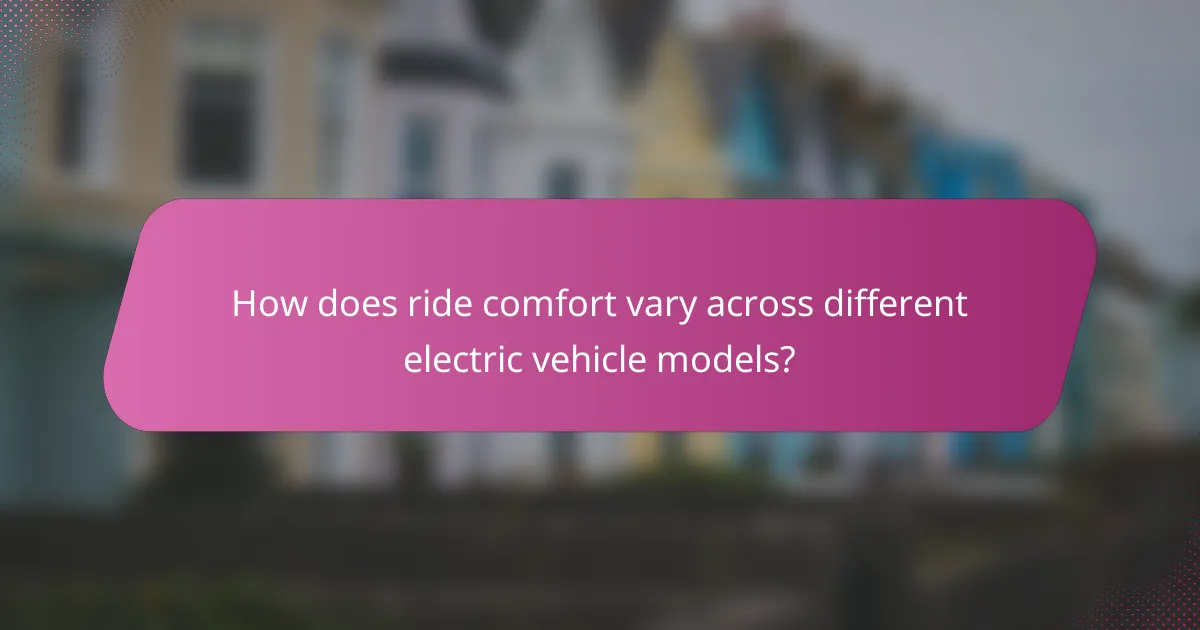
How does ride comfort vary across different electric vehicle models?
Ride comfort in electric vehicles (EVs) can differ significantly based on the model and its design features. Factors such as suspension systems, cabin noise levels, and seat ergonomics play crucial roles in determining how comfortable a ride will be.
Tesla Model 3 comfort features
The Tesla Model 3 is known for its minimalist interior and advanced suspension system, which contributes to a smooth ride. Its adaptive air suspension can adjust to various driving conditions, enhancing comfort on both highways and city streets.
Additionally, the Model 3 features noise-reducing materials that help minimize cabin noise, creating a quieter environment. The seats are designed for long-distance comfort, providing ample support for both driver and passengers.
Nissan Leaf ride quality
The Nissan Leaf offers a comfortable ride, particularly in urban settings, thanks to its compact design and responsive handling. Its suspension is tuned for comfort, absorbing bumps effectively and providing a stable driving experience.
However, some drivers may find the Leaf’s performance less engaging compared to sportier models. The cabin is spacious, but road noise can be more noticeable at higher speeds, which may affect overall comfort on longer journeys.
Ford Mustang Mach-E driving dynamics
The Ford Mustang Mach-E combines sporty handling with a comfortable ride, making it suitable for various driving styles. Its well-engineered suspension system strikes a balance between performance and comfort, allowing for a smooth experience on both winding roads and highways.
Inside, the Mach-E features supportive seats and a spacious cabin, enhancing passenger comfort. The vehicle also incorporates sound insulation to reduce noise, ensuring a pleasant driving experience even at higher speeds.

What are the key criteria for choosing an electric vehicle based on handling?
When selecting an electric vehicle (EV) based on handling, key criteria include suspension type, weight distribution, and overall size. These factors significantly influence ride comfort, stability, and driving experience, making them essential considerations for potential buyers.
Suspension type and tuning
The suspension system plays a crucial role in how an electric vehicle handles different road conditions. EVs often utilize independent suspension setups, which can enhance ride comfort and stability. Considerations such as the tuning of the suspension can affect how well the vehicle absorbs bumps and maintains traction during cornering.
For optimal handling, look for vehicles with adjustable suspension settings, which allow drivers to customize ride firmness based on personal preference or driving conditions. This flexibility can improve both comfort and performance, especially in varying terrains.
Weight and size considerations
The weight of an electric vehicle is typically higher due to the battery pack, which can impact handling characteristics. A lower center of gravity, often found in EVs, can enhance stability and cornering performance. However, it’s essential to balance weight with size; larger vehicles may feel less agile despite having advanced handling features.
When evaluating an EV, consider its dimensions and weight distribution. A well-balanced vehicle will provide a more enjoyable driving experience, particularly in urban environments where maneuverability is key. Test driving different models can help identify which size and weight combination feels best for your driving style.
